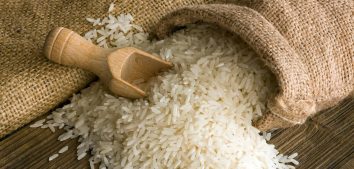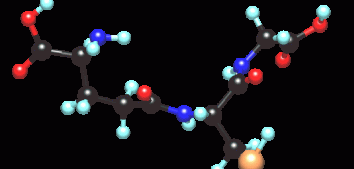
b vitamins
At the end of the 19th century new technologies were developed that enabled production of rice deprived of bran. The prices dropped, but so did the level of vitamin B thus effecting in an outbreak of beri-beri – a disease that leads to debility.
Vitamin B1 (thiamine)
The discovery of vitamin B1 let the scientists cure this horrible avitaminosis. Well, it seems we firstly deprived natural products of valuable minerals thus leading to horrible disorders and secondly – we cured those disorders by those exact same minerals – only synthetic. It’s an exceptional example of an absurd – ‘for the good of humanity’.
Vitamin B1 doesn’t react well for heat and alkaline environment. It disintegrates in just 15 minutes of boiling. If we added baking soda it would happen even faster. It’s sensitive and resistant to light. Processes in which grains are deprived of bran (production of white flour and white rice) also deprive the products of considerable amounts of thiamine.
Main functions:
- The conduction of nerve impulses
- the production of energy from food
- helper molecule – and so-called ‘coenzyme’ – which activates enzymes
- stimulates the process of gonadotropins production
If a diet is low in thiamine, organism will run out of its reserves after 2 weeks. Thus – delivering it to the organism daily is essential. Both alcohol and cigarettes increase vitamin B1 consumption. Also, athletes and breast feeding women need more thiamine.
Vitamin B deficiency causes excession of pyruvic and lactic acid in the tissues. It can result both in morphological and functional disorders in nervous system. It also affects heart functions.
The biggest amount of thiamine (per 100 g) can be found in: soya, meat, yeast, pulses and raw buckwheat.
Vitamin B2 (riboflavin)
Yeast and grain seeds are rich in riboflavin. We’ll also find it in milk, eggs, meat, wholemeal products and mackerel.
It’s rather resistant to heat, although light affect it and it loses biological activity as a
result.
Main functions:
- plays an important role in numerous metabolic pathways, such as those of fats, proteins and carbohydrates
- it assists energy release from food and is part of the electron transport chain which is central to energy production
- is vital for the nervous system
- plays a key role in mucus membrane maintenance, the maintenance of health of skin and red blood cells production
- plays a key role in the maintenance of health of the eyes
Deficiency symptoms:
- Eyes may be sensitive to bright light, they may also be itchy, watery and/or bloodshot
- Angular cheilitis – cracks at the corners of the mouth
- Cracked lips
- Dry skin
- anemia
Vitamin B3, vitamin PP (niacin, nicotinic acid+nicotinamide)
Niacin can be found in yeast (40), bran (35), peanuts (17), sea fish (8), meat (7-10) – per 100 g.
Niacin is highly resistant to light and heat. It doesn’t disintengrate next to oxygen, acids nor alkalines.
Main functions:
- contributes to normal function of the nervous system and normal psychological functions
- Produce macromolecules, including fatty acids and cholesterol
- key role in cortisol, thyroxin, insulin and sex hormones synthesis
- takes part in oxidation and reduction processes
- affects the health of the skin
It was discovered during research on a heavy disease – pellagra. It occured in environments where people were underfed. And yet again – it was proven that vitamin deficiencies lead to serious disorders or even death. Thus – let’s provide are diets with vitamins.
Vitamin B5 (pantothenic acid)
Vitamin B5 is present in each and every animal or plant tissue. The biggest amount of it can be found in yeast (5300), pulses (fresh peas – 2100), meat (400-2000), mushrooms (1700), eggs (1800), green veggies (broccoli – 1170). Unfortunately – products lose half of it during cooking.
Main functions:
- takes part in carbs, proteins and fats metabolism
- takes part in reactions that deliver energy for synthesis of many important compounds, such as antibodies
- takes part in skin regeneration
Research has shown than deficiency can result in burning feet syndrome, fatigue, sleep disorders. Also, the elderly, drinking and those using pharmacological contraception have a decreased level of vitamin B5.
Vitamin B6 (pyridoxine)
Pyrodixine can be found in many products, but in small amounts. The biggest amount can be found in yeast (1,1), meat (0,2-0.5), fish (0,38), pulses, wholemeal grains and leafy greens. Its level decreases during any treatment, such as freezing, cooking or grains shredding.
Main functions:
- involved in amino acid metabolism
- plays a key role in cognitive development, essential for nervous system
- involved in glucogenesis and glycogenesis
As vitamin B6 takes part in the biosynthesis of neurotransmiters its deficiency may result in neuronal aging, neuropathy, convulsions and depression. The reasons for deficiency (apart for diet) include alcohol intake or drugs usage. Animals with vitamin B6 deficiency were diagnosed with fatty liver disease, atherosclerotic disease and decreased level of insulin synthesis.
Folic acid (B9)
It’s a vitamin essential to our health, it’s importance begins in prenatal period. Fortunately, it can be found in many products. Food rich in folic acid: liver (220), leafy greens such as spinach (155), Brussel sprout (100), broad bean (130), peas (87), cauliflower (120), broccoli (90). It’s best to eat them raw or blanched.
Folic acid can also be found in yeast, eggs and grain sprouts.
It’s not resistant to heat, sunlight or acid. Cooking considerably decreases the level of folic acid, for example – raw spinach has 155 µg per 100 g, while boiled has only 29-90 µg per 100 g.
Main functions:
- key role in amino acids metabolism
- key role in red blood cells production
- essential for cell growth
- essential for normal nervous system function
Complications of folic acid deficiency:
- megaloblastic anemia, where RBCs are larger than normal and not fully developed
- the elderly – physchological dysfunctions
- serious birth defects in the spinal cord and brain of a developing fetus, neural tube defects.
- increased risk of tumors
The high-risk group consists of pregnant women, teen girls and elderly people. The causes of deficiency include digestive tract diseases, smoking, alcoholism, slimming diets and some drugs.
Avaragely, an adult needs at least 100 µg of folic acid daily.
Vitamin B12
Vitamin B12 is actually the name of a group of substances, including cobalt for instance. One of its chemical names is cobalamin.
The richest source for vitamin B12 is beef liver (122), veal liver (104), veal kidneys (63), chicken liver (24), oysters (21), egg yolks (9,3), tuna (2,8).
Vitamin B12 is the perfect argument for meat lovers: they state that vegeteraians deprive themselves and their children of an important nutrient.
That’s true – cobalamin in essential for our functioning. Especially for our nervous system. That’s why vegeterians should supplement it.
Main functions:
- takes part in amino acids synthesis
- essential for blood morphotic elements production
- takes part in myelin building
- takes part in DNA synthesis
- essential in polyglutamic acid synthesis
As you can see – cobalamin deficiency may be very harmuful, a life threat even. It leads to pernicious anemia and nervous system defects.
Vitamin B12 is also synthesized by our microorganisms (gut flora) so vegetarians are safe. It’s stored in liver and reserves are being used for months. Deficiency is often caused by absorption disorders – gastric mucosa doesn’t produce the substance that synthesizes cobalamin. Calcium ions are also essential for right absorption.
An average adult needs 2 µg daily. B12 is rather resistant, the lossed during cooking process are small.














Comments No Comments
Join the discussion…